Pickleworms first appeared in the United States in 1869 when they were discovered inside pickling cucumbers, hence the name. While this caterpillar does attack cucumbers, it prefers summer squashes, like yellow squash, zucchini, and pattypan (scallop) squash. It will also attack other cucurbits like cantaloupe, pumpkin, winter squash, and sometimes watermelon, although it is less likely to burrow into these types of fruit.
This voracious eater can vary in color depending on its developmental stage and what it has been eating. In the early stages, the caterpillar’s head is brown and its body is white to yellow with dark spots. As it matures, it becomes green. In its fifth and final instar, it will measure 1 inch (2.5 cm) in length and lose its spots. Before it pupates, it will turn a dark copper color.
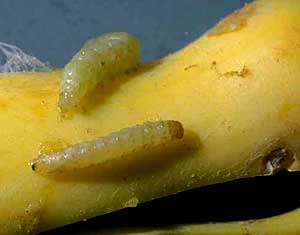
The pickleworm prefers warmer climates with mild winters but will migrate north when conditions permit. It can be found from Canada into parts of South America, but it is more commonly seen throughout the southern part of the United States.
Life Cycle
Pickleworms are the larval or caterpillar stage of a nocturnal moth that is one inch (2.5 cm) long body and has a wingspan of 1 to 1.25 inches (2.5 to 3.2 cm). The wings have a distinct pattern that includes a dark brown border with a yellow iridescent center. Both male and female moths have a bushy tail on the tip of their abdomens.
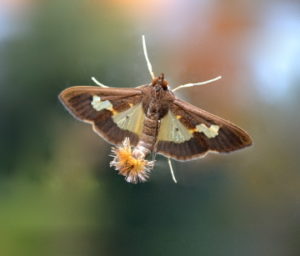
The female moth lays tiny white eggs that measure a mere .5 mm in width, about the size of a grain of sand, and are thus, difficult to see. They are laid in clusters of between two to seven eggs, often on cucurbit buds, flowers, or young, tender foliage. One day after being laid, the eggs will turn yellow. A single female can lay between 300 and 400 eggs in its lifetime.
White larvae will emerge from the eggs in about four days and begin to feed on the host plant. Some larvae spend the entire five instars feeding only on buds, flowers, and other soft plant tissue, while others will migrate to fruit when they are halfway through the developmental process, which takes between twelve and sixteen days.
The mature larva will form a cocoon, usually consisting of only a few strands of silk in a leaf fold or leaf roll, where it will pupate for eight to nine days. The entire process, from egg to adult moth, takes about thirty days to complete.
Telltale Signs
Other than the pickleworm itself, there are telltale signs of the caterpillar’s presence. You may find small holes or other signs of damage on buds, flowers, stems, and leaves as the caterpillars tunnel through plant tissue. Like squash vine borer larvae, pickleworm larvae make small holes as they tunnel into the fruit, and you may see frass (larvae excrement) on the exterior of the fruit or on leaves where it has fallen.
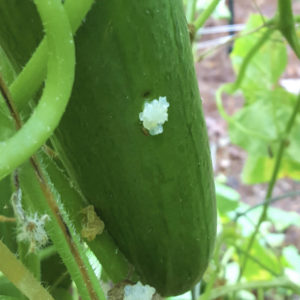
Damage
Damage to buds and flowers will disrupt or prohibit fruit development, while fruit that has developed is ruined by tunneling larvae. What’s more, fruit skin or rind that has been breached is an open door for fungus and bacteria to develop inside the fruit, causing it to rot. If the fruit has a tougher skin or rind, like cantaloupe, pickleworms may feed on the surface instead of tunneling in the fruit, leaving scars behind.
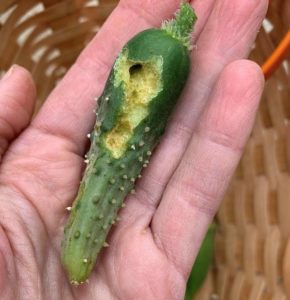
How to Control Pickleworms
Natural Predators – The pickleworm’s natural enemies include birds, bats, soldier beetles, fire ants, and several species of parasitic wasps. When these are not available in numbers sufficient to eliminate the pest, there are additional measures that can be taken.
Remove by Hand – Removing caterpillars by hand can be an effective method if you start early in the season and are consistent. You will need to monitor your garden regularly so as to ward off any problems. Dispose of eggs and caterpillars in soapy water.
This article contains affiliate links. If you make a purchase using one of these links, I will receive a very small commission at no additional cost to you, and it will help me maintain this website. Rest assured, I only recommend products I actually like!
Neem Oil – Cold-pressed neem oil with the naturally occurring compound, Azadirachtin, is an effective organic insecticide used to combat pickleworms. It works as an antifeedant and by interrupting the insect’s life cycle and causing contact toxicity. It is not an instant remedy but will take a little time to see results. Be sure to follow package directions and remember not to apply neem oil to flowers as it will harm honeybees. Also, do not apply during the day as the combination of sun and oil can burn the plant. Always do a test spray on a leaf before spraying the entire plant. Apply once a week as needed. This is the neem oil I use.
Bagging Fruit – Placing breathable, fine mesh bags over fruits and vegetables is an effective way to protect them from burrowing caterpillars. The bags are available in different sizes and are reusable.
Bird Netting – Cover vulnerable crops with bird netting that has holes no larger than 3/4 of an inch in diameter. Since the moths have a one inch wingspan they will not be able to pass through the netting to lay their eggs.
Row Covers – Another way to protect your plants from pickleworms is to use row covers. Since the pickleworm moth is nocturnal, this method will require you to cover the vulnerable plants in the late afternoon before the moth becomes active and remove the cover in the morning to give pollinators access to the flowers. The cover acts as a barrier to keep the moth from laying eggs on vulnerable plants.
Spinosad and Bacillus thuringiensis (Bt) are microorganisms that are derived from soil bacteria. They can also be effective against pickleworms. Be sure to read and follow label directions carefully. Personally, I recommend using neem oil instead of these. It is important to note, however, that neither Spinosad, Bt, or neem oil are effective against caterpillars once they have tunneled inside the fruit.
Plant Resistant Varieties – Since squash is the preferred food of the pickleworm, you may want to consider growing more resistant varieties such as Early Prolific Straightneck, Butternut 23, Summer Crookneck, and Early Yellow Summer Crookneck. As for cucumbers, you may want to plant parthenocarpic cucumbers, also known as greenhouse cucumbers, because they do not require pollination.
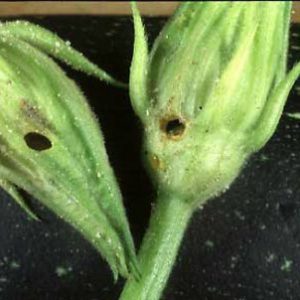
Plant Early – Some recommend planting cucurbit crops early to shorten the crops’ exposure to pickleworms. This will depend on where you live. For example, pickleworms are at work in the garden in late June and early July in Florida and Texas, but not until August and September in North and South Carolina. Check with your county’s extension office to determine the best time to plant in your area.
Plant Extra Crops – If you have a history of problems with certain crops be sure to plant extra so that you will have the harvest you desire if some plants succumb to pests or disease.
Remove Plant Debris – Remove plant debris in and around the garden where pickleworm larvae may overwinter. Be sure to destroy and discard plants and fruit that have been infected by pickleworms at any stage. Do not compost them as most compost piles do not get hot enough to destroy the eggs or insect.
Pickleworms can be very destructive pests. But with a little planning, prevention, and intervention they don’t have to spell disaster for your summer garden.
Thank you for reading this article! If you found it helpful, please consider sharing it with others via email or on social media!
[1] Diaphania nitidalis (Stoll) (Insecta: Lepidoptera: Crambidae), University of Florida Institute of Food and Agricultural Sciences, https://entnemdept.ufl.edu/creatures/veg/pickleworm.htm
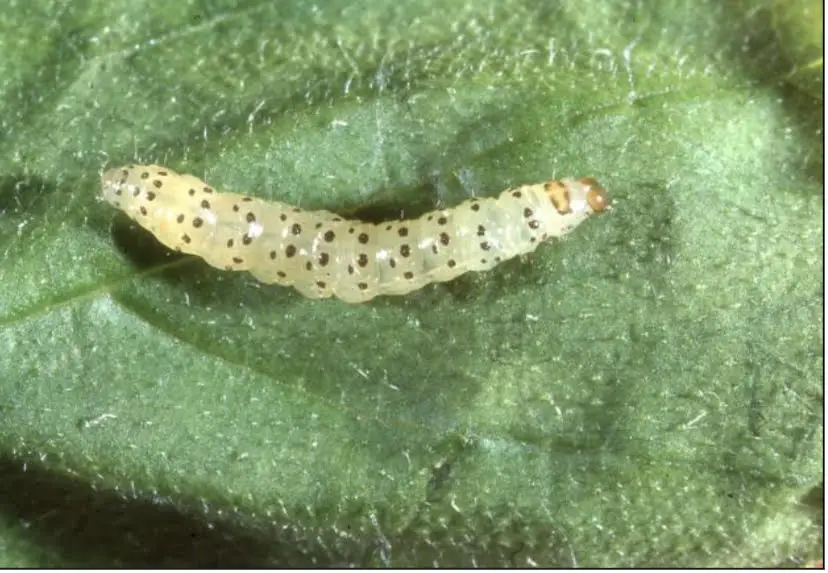
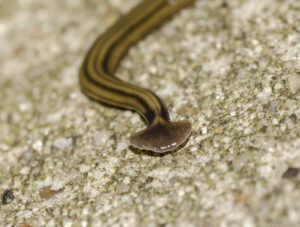
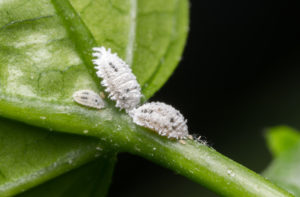
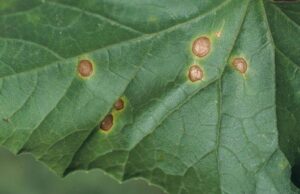
Thanks for the post. I found my first pickle worm this morning and I’m really sad!
Greetings Nat!
Thanks for taking the time to read the article and comment. Sorry to hear that you have pickle worms, but hopefully, now you know how to treat them.
Best wishes!
I have not seen any suggest an individual sock over each squash to prevent pickel worm .
Hi Kenneth!
You’re right, I don’t think I’ve heard of using a sock either. I wonder, however, if the material would prevent air flow. Perhaps the leg from a panty-hose or a nylon “knee high” stocking would be a good alternative.
Thanks for reading and commenting!